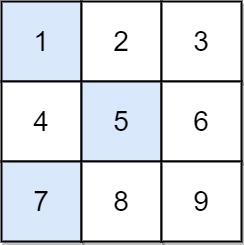Given an n x n integer matrix grid, return the minimum sum of a falling path with non-zero shifts.
A falling path with non-zero shifts is a choice of exactly one element from each row of grid such that no two elements chosen in adjacent rows are in the same column.
Input: grid = [[1,2,3],[4,5,6],[7,8,9]] Output: 13 Explanation: The possible falling paths are: [1,5,9], [1,5,7], [1,6,7], [1,6,8], [2,4,8], [2,4,9], [2,6,7], [2,6,8], [3,4,8], [3,4,9], [3,5,7], [3,5,9] The falling path with the smallest sum is [1,5,7], so the answer is 13.
Input: grid = [[7]] Output: 7
n == grid.length == grid[i].length1 <= n <= 200-99 <= grid[i][j] <= 99
impl Solution {
pub fn min_falling_path_sum(mut grid: Vec<Vec<i32>>) -> i32 {
if grid.len() == 1 {
return grid[0][0];
}
let mut min_col2 = [grid.len(); 2];
let mut min_sum2 = [0; 2];
for r in 0..grid.len() {
let mut i = grid.len();
let mut j = grid.len();
for c in 0..grid.len() {
if c != min_col2[0] {
grid[r][c] += min_sum2[0];
} else {
grid[r][c] += min_sum2[1];
}
if grid[r][c] <= *grid[r].get(i).unwrap_or(&i32::MAX) {
j = i;
i = c;
} else if grid[r][c] < *grid[r].get(j).unwrap_or(&i32::MAX) {
j = c;
}
}
min_col2 = [i, j];
min_sum2 = [grid[r][i], grid[r][j]];
}
min_sum2[0].min(min_sum2[1])
}
}